Brus is a unique card game of the shedding variety, which is played in Sweden, particularly on the island of Gotland. The most popular version of the game is designed to be played by four players in two partnerships, although a six player version is described in the variants section below.
The game is played with a special 36 card deck, which is divided into various card types, namely "Playable Cards", "Unplayable Cards" and "Trick" cards. To create the deck to be used for playing Brus, all the cards of rank 2, 3, 4, and 5 are removed from a standard 52 card deck and the remaining cards are shuffled.
Determination of partnerships and first dealer can be determined in a number of ways. One common method is for each player to draw a card from the deck and the players drawing the two highest card (using the traditional ranking of a standard 52 card deck) to play as partners against the two players drawing the two lowest cards. Each partner should sit directly across from his partner at the table. The player drawing the highest ranked card of all is set as the first dealer. Thereafter, the role of dealer rotates in a clockwise direction after each hand.
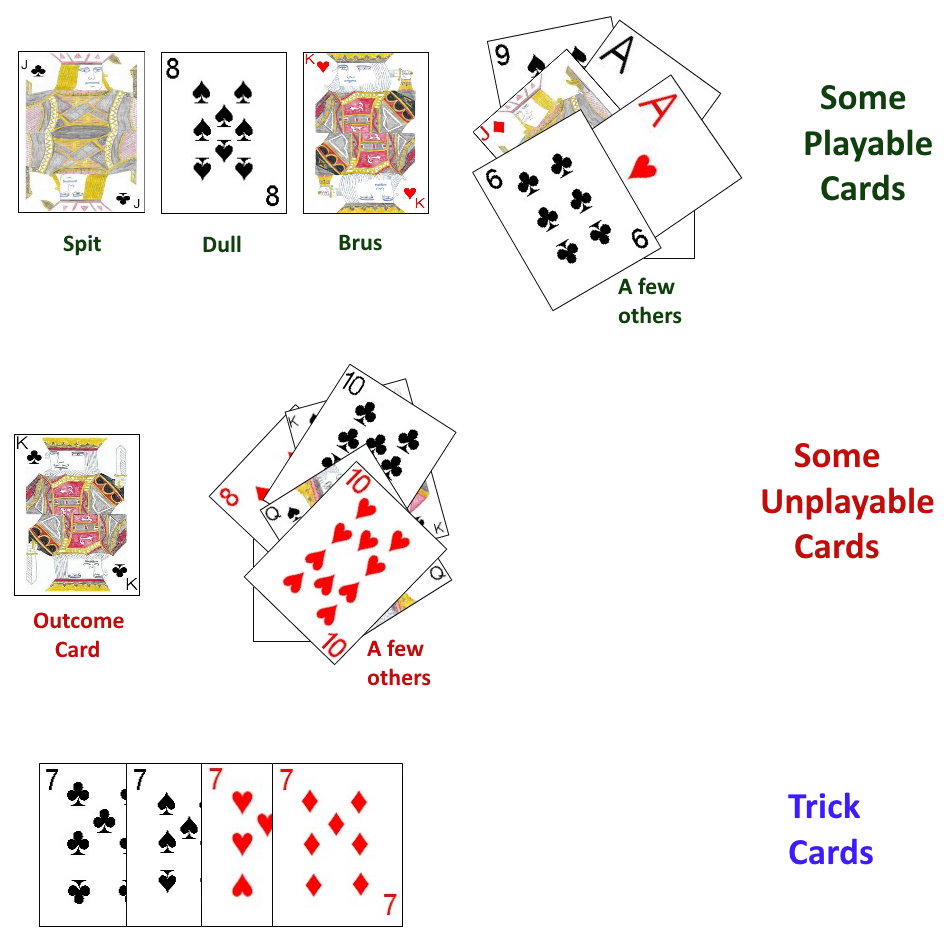
As mentioned previously, the remainder of the cards in the deck can be thought of as in several category of cards, which are:
- Playable Cards:
These are 18 cards which can normally be played to a trick, in an attempt to win the trick. Each of these cards has a unique rank. The following are all the playable cards, listed in rank from highest to lowest of these cards: Jack of
clubs (Called
Spit), eight of spades (called Dull), King of hearts (called Brus), The four nines (each
nine then further ranked by suit; clubs, spades, hearts then diamonds), The Aces (each then ranked by suit;
clubs, spades, hearts, diamonds), Jack of spades, Jack of hearts, Jack of diamonds,
sixes (further ranked by suit; clubs, spades, hearts, diamonds).
- Unplayable Cards:
These 14 cards are considered unplayable cards and can never be played, remaining in a players hand for the entire hand. They have no relative ranking as they are never actually played (although the King of
clubs does have a special feature which will be described shortly). The unplayable cards are as follows: Eight of
clubs, Eight of diamonds, Eight of spades, 10 (one each in hearts, spades, clubs and
diamonds), Queens (in each in hearts, spades, clubs and diamonds), King of clubs, King of
spades, King of diamonds. As mentioned previously, although considered an unplayable card, the King of
clubs has a special function which may help determine the winner of a hand in certain cases in which no player managed to score enough points to win that hand.
- Trick Cards:
The four sevens (one each in the suits of clubs, spades,
hearts, diamonds) are similar to Unplayable cards, however one or more such cards can be led by a player who currently has the lead and will enable that player to score points during the current hand.
To begin, the currently designated dealer would begin dealing the cards in a clockwise direction around the table starting with the player at his immediate left, dealing cards one-by-one and face-down in front of each player. He continues dealing until each player has a total of nine cards. The player to the immediate left of the current dealer then has the first opportunity to lead.
On this lead, a player may take one of several actions:
- Leading a Trick Card:
If a player, on his turn has one or more sevens he may play one or more of these cards to the table. As sevens are unbeatable cards, this is considered the highest play, and the player of the Sevens takes these cards and places these cards to the side, out of play. After making this play, the same player again has the Lead. Each such seven (Trick card) played earns this player 1 "trick".
- Lead a Playable Card:
On his turn, a player with the lead may play any Playable card (see above) from his hand to the table. This would normally end this player's turn.
- Pass:
If the player has no Playable cards in hand, he must pass his turn, with the opportunity to Lead passing to the next player to that player's left.
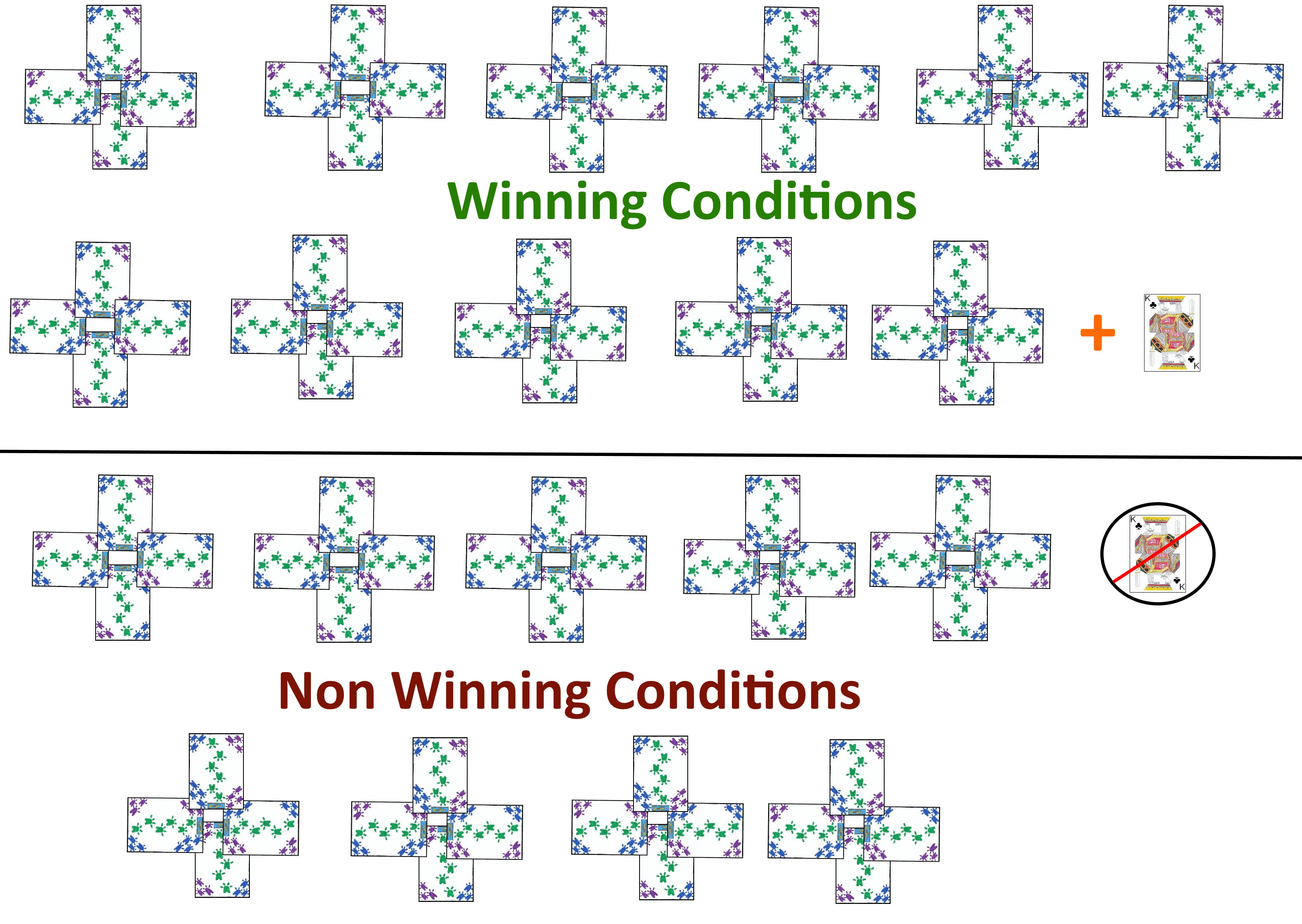
After the Leader plays a Playable card to the table, each other player in turn then has the opportunity to play a card to this trick. He may only play a card to the trick if he has a higher ranked Playable card than the current highest card played to the trick. If the player has no higher ranked Playable card he can play to the trick he must simply pass,
not playing a card to this trick. After each other player has then had the opportunity to play to the trick, that trick is complete. The player of the highest ranked Playable card to the trick wins that trick, setting it aside, which is considered 1 "trick" for that player.
Play continues until one of two occurrences, either one partnership manages to earn six tricks during play of that hand or no player has any remaining playable cards in hand. In the first occurrence, the team who managed to earn six tricks during the hand wins one point. However, if that team won the first six tricks of the hand (called Jan), they win two points instead.
In the second occurrence in which no players have any remaining playable cards in hand, if one team manages to win five tricks during hand AND one member of that team has the King of
clubs (called the
"Outcome card") in hand, that team is considered the winner of the hand and earns 1 point. However, if neither occurrence applies to a specific hand, neither team is considered to have won the hand and neither team scores on that hand.
After a set number of hands, the partnership which has scored the highest cumulative number of points is declared the winner.
Six Player Variant: While the standard game of Brus is designed to be played by four players, it can also be easily adapted for play by six players. In this variant, the players are divided into two teams of three players each. The players should be seated at the table in such a manner that each player is surrounded by two member of the opposing partnership. Another difference in this variant is that each player is dealt a total of six cards instead of nine as in the standard variant.
Aside from these two differences, this variant is played identically to the standard version of Brus as described at the top of the page.
Voormsi: Voormsi is a game from the same family of Brus,
however this game originated instead in the nearby country of Greenland. Voormsi is thought to be an extremely old game,
commonly played in the early 1700's
during the whaling period in Greenland's history. The game is also commonly known by the alternate but similar name Vorms.
Voormsi is designed for play by four players in two partnerships of two players each.
Each player should be seated directly across the table from his partner. As in Brus, Voormsi uses a modified, reduced deck with some unusual rankings of the cards in that deck.
The deck can be created by removing all cards lower than the fives from a standard 52 card deck as well as removing the four tens. In addition, the King of
diamonds should be removed from the deck used for play and replaced with the three of diamonds from the pile of unused cards in the deck. This should create a deck of 36 total cards for use in play.
As in Brus, the cards as used in this game have a somewhat unusual ranking and this ranking can also be effected by whether the card is led to a trick or played to an existing trick. The ranking of the cards are describes as followed, from highest to lowest:
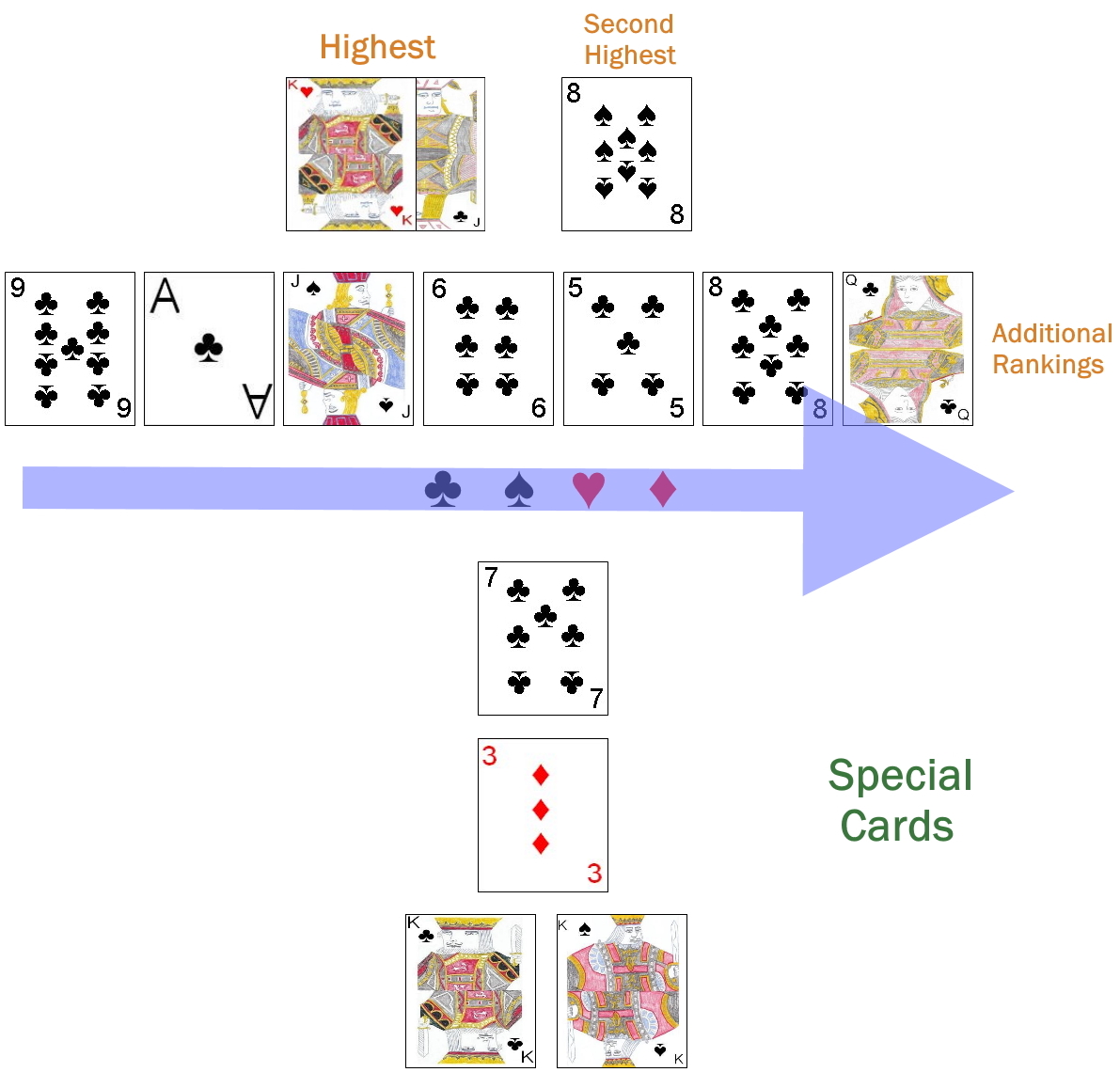
- The two highest (and equally ranking) cards in the deck are the King of hearts (called Voormsi) and the Jack of clubs. As both of these cards are considered of equal rank, if both cards were to be played to the same trick, the second of these cards played to the trick is considered the higher
of the two.
- The third highest card in the Voormsi deck is the eight of spades.
- The next four highest ranking cards are the nines. These are ranking amongst one another by suit, as follows (high to low): clubs, spades, hearts, diamonds.
- Next in line of rank are the four Aces. As with the nines, each Ace can
be further ranked by suit in the order of clubs, spades, hearts, diamonds.
- After the Aces are the three remaining Jacks. These are ranked,
relative to each other in the order; spades, hearts, diamonds.
- The next highest ranking cards are the sixes. Of the cards of this same
denomination, these are ranked by suit in the order; clubs, spades, hearts, diamonds.
- Next in order of ranking are the four fives. These fives are then further ranked by suit;
first clubs, next spades, then hearts, lastly diamonds.
- The next highest ranked card, after the fives are the three remaining eights. These are ranked amongst each other by suit; clubs, hearts, diamonds.
- After the eights, the Queens are next highest. Amongst multiple Queens played to the same trick, these cards are further ranked by suit; clubs, spades, heart, diamonds.
- The two remaining Kings are the next cards in order of ranking. Of these
two cards, the King of clubs is ranked higher than the King of spades. However, these Kings
also have special capabilities, to be described below.
As will be noticed, however, with this ranking, there are several remaining cards in the deck which have not yet been
included in these card rankings, specifically the sevens, and the three of diamonds.
- Sevens:
If a seven is played to an existing trick which was led by a non-seven, it can never win that trick. However, if any
seven is led to a trick, it can only be beaten by a higher ranked seven (with the sevens ranked amongst one another by suit; clubs, spades, hearts, diamonds), the King of clubs, or the three of diamonds.
- Three of diamonds:
If led to a trick, the tree of diamonds can
never win that trick. However, if played to an existing trick, the three of
diamonds will always win that trick, regardless of the cards played by the
other players.
- Kings of clubs and spades:
Although normally ranked as the lowest cards in the deck, the Kings can be used in special ways. As mentioned previously, a seven led to a trick can be beaten only by a very few cards, with the King of clubs one such card. If, the very next player in turn,
after a seven is played, plays the King of spades to that same trick, the King of spades will win that trick. The only cards that can beat the King of clubs which was played to a trick led by a seven, are thus the King of clubs and the three of diamonds, and the only card that can beat the king of spades, played in this circumstance is the three of diamonds.
The usual method to select the dealer is for the players to each draw a card from the shuffled deck. Using the ranking as above, the player drawing the lowest card is set as the first dealer. After each hand, the role of dealer rotates in a clockwise direction around the table. Once selected the dealer then deals four cards to each player, starting with the player at his immediate left and continuing in a clockwise direction. He should deal the cards one-at-a-time and face down in front of each player. After each player has the requisite four cards, the dealer places the remainder of the deck face-down in the center of the table as the stock pile.
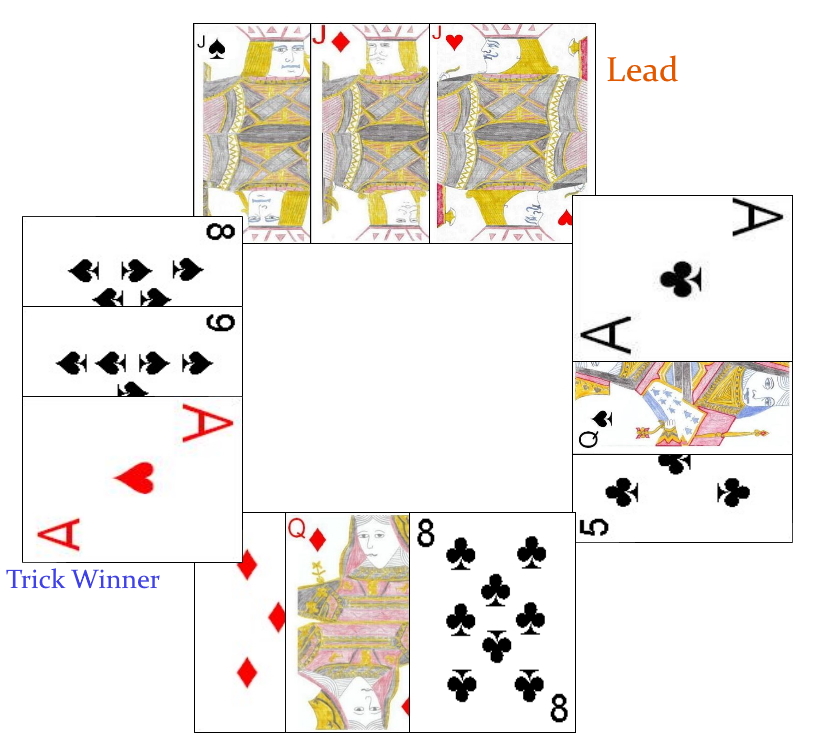
Once the cards have been dealt, the player to the dealer's immediate left then has the first turn. In leading to a trick, the leader may play any card of his choice from his hand, playing this card face-up near the center of the table to start the trick. If that player has multiple cards, all of the same
denomination (such as 3 nines), he may play all such cards as the lead
to that trick. Each other player in a clockwise direction then must play
the same number of cards, also face-up, to the trick as was first led to
it. There is no obligation to necessarily win the trick, although in
many cases players will attempt to thus win it for point scoring purposes. There is
one exception to this rule regarding attempting to beat a trick. If a
member of the opponent's team is currently winning the trick and the card
so winning the trick is the Jack of clubs, if the player has the King of
hearts in hand, he must play it as part of that trick in an attempt to
win the trick. In order for a player to attempt to actually win
the trick, he must beat each of the cards which are currently winning
that trick (play a higher ranked card). Although if leading to a
trick with multiple cards, all cards so led must be of the same rank,
there is no similar requirement on playing to (or winning) an existing
trick previously led by another player.
Once each player has played the requisite number of cards to the trick,
the trick is examined to determine the winner. Thus, upon leading the,
the leader to the trick is said to be winning that trick. If a
subsequent player is able to play a higher ranking card (as per the card
rankings described above), for each card led to that trick, this player
then is said to be winning the trick. In order for another player to win
said trick, they must then beat each individual card as played by the
player currently winning that trick. The winner of each trick, takes the
cards from that trick setting them aside, out of play, and will lead the first card (or cards) to the next trick. However, before doing so, each player, starting with the winner of the trick, and continuing in a clockwise rotation around the table, should draw enough cards from the stock to replenish his hand back to four cards. If there are not enough cards remaining in the stock, only enough cards should be drawn by each player such that each player will draw the same number of cards. Once the stock is exhausted, the players play out the
remaining tricks from the hand.
Note that although a player may, as able and willing with matched cards, play multiple cards to lead to a trick, the trick is won as a single unit (a player must beat every card in the trick to win it). However, a trick consisting of multiple cards is actually considered, for purposes of scoring and counting the number of tricks a partnership has won
during the hand, to be equal to a number of tricks as the number of cards led to that trick.
After all tricks have been played and won, calculation of the scores for the hand occurs. The following are the scoring opportunities during the game:
- Whichever team, amongst the two players forming that team, manages to win more than five tricks, earns one point plus one additional point for each trick won in excess of five during that hand.
- If one team manages to win the first five consecutive tricks in the
hand, that team earn one point for this feat.
- Winning the Voormsi (King of hearts) also often earns points for the player capturing it in a trick, based on certain criteria:
- Simple capture:
If a player manages to capture the Voormsi during a trick, using the Voormsi to win that trick, he earns one point for his team. However, he does not earn a point if the Voormsi was the last card played to that trick, if the Jack of clubs has already been played to a previous trick during the current, or the player of the Voormsi also has the Jack of clubs in his hand.
- Capture by Jack of clubs:
If the Voormsi was played to a trick and is currently considered to be winning that trick, if a member of the opposing team managers to capture that trick by play of the Jack of clubs, he earns two points for his team.
- Partner capture:
If the Voormsi was played to the trick and is currently considered to be winning the trick, and the partner of the player who played the Voormsi wins the trick with the Jack of clubs, his team must reset the score for that team back to 0 and the game immediately ends with the opposing team declared the winner.
- Three of diamonds capture:
If a player manages to win a trick in which the Voormsi was played (by any player) and is considered to currently be winning the trick, by play of the three of diamonds, that player earns one point for his team.
- Three of Diamonds double capture:
If a player manages to win a trick, using the three of diamonds from his hand, in which the Jack of clubs is currently winning, and which the Voormsi was previously played on that same trick, earns that player's partnership two points.
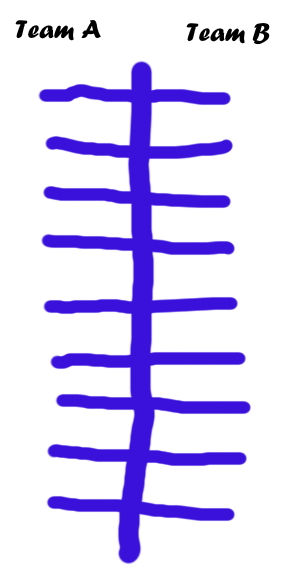
Note that if one team manages to win all nine tricks during the hand, no scoring is earned by either team on that hand.
Scoring for this game is usually recorded either on a slate or a piece of paper using a series of lines, which are progressively erased from the diagram as the game continues. At the start of the game, a large vertical line is drawn on the paper or slate, through which nine smaller perpendicular,
horizontal lines are drawn through, extending out from each side of the vertical line.
This diagram is sometimes referred to as a ladder based on it's
resemblance to a climbing structure. Each team is assigned one side of the vertical line. As the teams score points after each hand, they erase an appropriate number of these perpendicular lines on their side of the vertical line, to coincide with points earned during the hands.
The goal of each team is, over the course of multiple hands, score exactly nine points (erasing all nine lines), but no more. The first team to accomplish this wins the game. To this end, a team can thus announce they have won in the
middle of a hand, if they would have earned enough points already during to bring their score to exactly nine points. However, the game cannot be ended in this manner until the partnership who believes they have earned the requisite additional points has lost a trick. If a team, at the end of a hand, or after the game is stopped due to a call, is found to have over nine points, that partnership's score is then set to a value of nine minus the number of points which they exceeded nine.
Once one partnership, at a hand stoppage, or the end of any hand, has scored exactly nine points that team is then declared the game winner.
Three Player Voormsi: Voormsi can also be played by three players rather than four. The game is played exactly the same as the four handed version, with the following differences:
- There are no partnerships, and each player plays and scores for himself.
- There are a total of twelve tricks to be played and won during the game.
- The game is to twelve points vice nine, and thus each player keeps a score using a vertical line with twelve horizontal lines drawn across it.
- Winning the first five consecutive tricks does not earn this player any bonus points.
Other than these differences, the three player version is played identically to the four player version.
Two Player Voormsi: Voormsi can also be played by two. The two-handed version is also played similarly to the standard, four player variant with the following differences:
- There are obviously no partnerships, with each player playing and scoring
strictly for himself.
- In order to simulate the normal, four player game, each player plays
twice to each trick. For example the leader first leads to start the trick (as in the regular
game), then his opponent plays to that same trick, the leader again plays a
card to that same to the trick, and the opponent then completes play to the trick. Whichever player managed to play the highest card to the trick wins it and will lead to the next trick. It should be noted that players may run out of cards while the trick is still in progress. In that case, the player who currently appears to be winning the trick draws first from the deck to replenish his hand to four cards, and his partner then draws next.
In all other aspects, the two player variant is played the same as the normal, more common four-handed version.
Twelve Card Voormsi: In some games, the dealer deals out the entire deck (nine cards per player) at the start of the game. Thus, the players will simply play out from the larger hand of cards and there is no drawing from the stock. In all other ways this version is played the same as the standard variant.
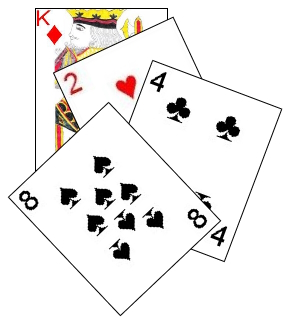 Alkort
Alkort: Although Alkort is played similarly to Brus and some of the other games described on this page, it is much older than most of these, and is actually considered one of oldest games played in Iceland (mentioned in printed materials from the early 1700's). The basic game of Alkort is played by four players, playing in two partnerships of two players each. Each player should be seated directly across the table from his partner.
The game uses a somewhat unusual 44 card deck which can easily be created by removing all cards of denomination 10 and 5 from a standard 52 card deck. As in Brus, the ranking of the cards used in Alkort is also highly unusual. The following chart shows the following categories of cards, and their ranking:
- The highest card in the entire deck is the King of diamonds.
- The second highest ranked card is the two of hearts.
- The next highest ranked card is the four of clubs.
- The next highest card is the eight of spades.
- Next is the nine of hearts.
- The next highest rank is the nine of diamonds.
- The next highest ranked cards are the four Aces. Each of these Aces is equally ranked amongst each other.
- The next highest would then be the four Jacks. Each of these cards is equally ranked amongst each other.
- The next highest ranking of card would be the sixes. Each of these are equally ranked amongst each other.
- The next highest ranking cards are the eight of clubs, eight of hearts,
and eight of diamonds. Amongst these three cards, each is equally highly ranked.
- Rubbish Cards - All other cards in the deck, which are not previously mentioned are considered rubbish cards (except the four Queens and the King of hearts, King of spades, and King of clubs which are mentioned below.)
- The lowest ranking cards, which are also considered "Rubbish cards" are the four Queens and the King of hearts, King of spades, and King of clubs.
The designated dealer for the hand then deals the cards in face-down batches of three, starting with the player at his right and continuing in a clockwise direction around the table, until each player has a total of nine cards. The remaining cards in the stock (which should consist of 8 cards) is placed face-down in the center of the table.
The players then pick up their hands for examination. If any player finds that his hand contains all Rubbish cards, he may show his hand, declaring himself "no friðufær". In this case, he discards all but one of the cards from his hand (setting these discarded cards to the side and out of play) and takes the eight cards from the stock to replenish his hand to 9 cards.
After this, each partner is entitled to show his partner the highest card he has in his hand. This should be done in such a manner that the members of the opposing partnership cannot see these cards. After this show of cards, play of the hand begins with the player to the immediate left of the dealer playing the first card to the first trick. Each other player in a clockwise direction around the table then plays one card of choice from their hand to that same trick.
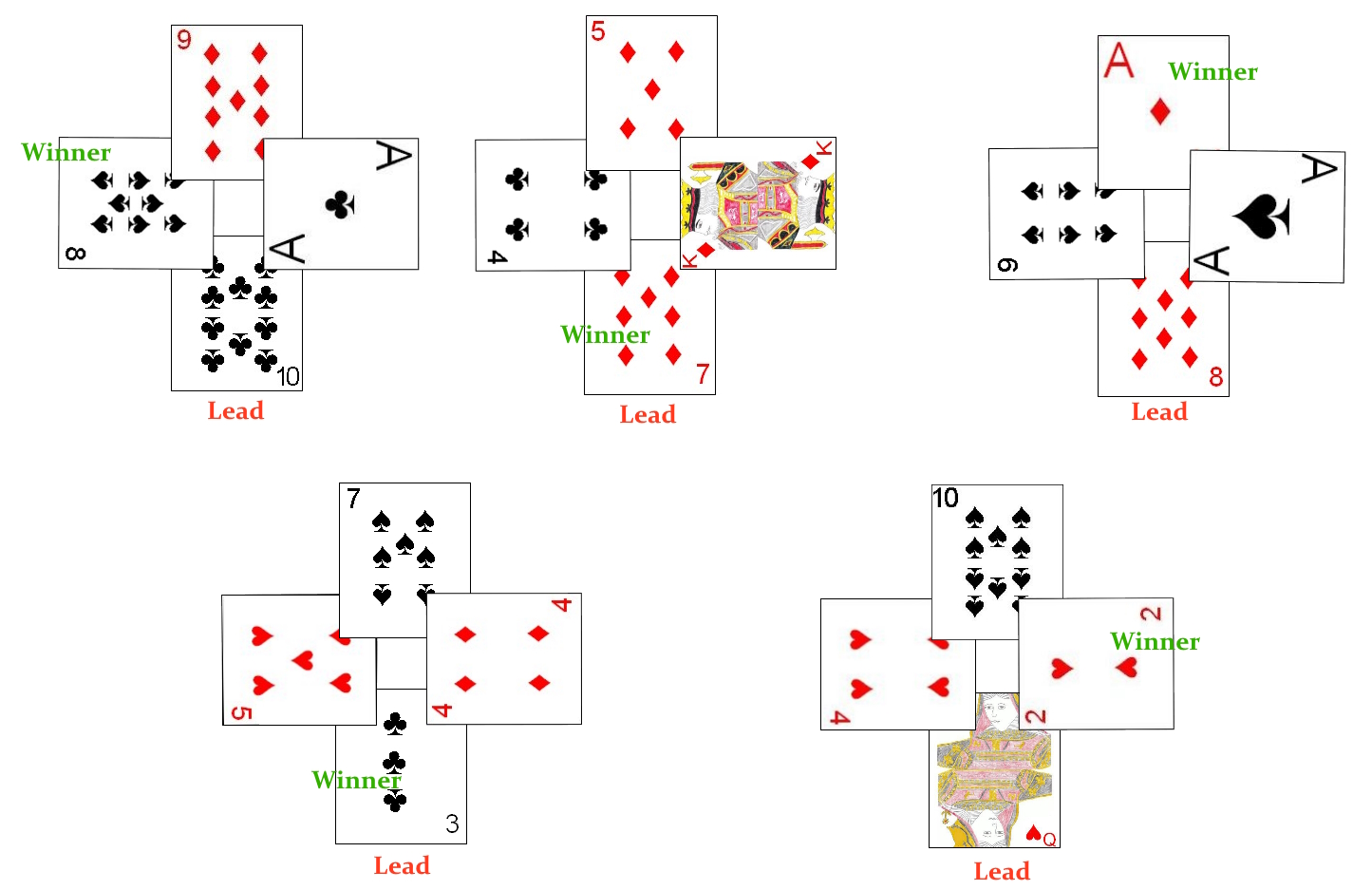
Each of the players to the trick including the leader to a trick may play any card of choice, still remaining in his hand to the trick. The highest card played to the trick wins the trick. If two or more cards of the same rank (as per the ranking shown above) are tied for highest to be played to that trick, the first of these cards played to that trick is considered the highest. The winner of each trick leads the first card to the trick.
There are a few special circumstances, however, during the game in which the player to win the trick may not necessarily be the player of the highest card from the normal ranking as described above:
- If a seven is led to any trick, no other card can beat this card. A seven played to any existing trick cannot win the trick. A player may not lead a seven to a trick unless he has previously won at least one trick during the current hand.
- If a rubbish card is played to the trick and all other cards played to the trick were also rubbish, the leader to the trick wins it.
- If the King of hearts, King of spades, or King of diamonds is led to a trick, however, it can be beaten by any non-rubbish card, or any two if a two is played to that same trick.
- If any Queen is led to a trick, it can be beaten by any non-rubbish card, or by any two or any three played to that trick.
The team that manages to win five of the nine tricks is declared the winner of the game (earning one game point). However, if one team manages to win the first five tricks of the game (before the opposing team has won any trick), the winning team earns 5 game points (called a múk). Each additional trick won by that team, after the first five, and before the opposing team scores a single trick is called a stroke. This can be a stroke consisting of 6, 7, 8 or 9 cards, depending on how many tricks the team wins before the opposing team wins a trick (a nine card stroke is one in which one team wins every trick during the hand). For a stroke, the winning team earns a number of game points equal to the total number of tricks won by the team before their opponents won a trick during that hand.
Two-Player Alkort: Although the four player variant of Alkort is most common, there is also a two player variant of the game. The two player version is identical to the four game with the only difference being the number of players. Since there are no teams, players will not show their highest cards to the other player.
Treikort: Treikort is essentially a three
player version of Alkort, sometimes even called 3-Man Alkort. The game is designed for three players, each playing independently. The game is played with a special
27 deck consisting of the following cards (which are shown ranked from highest to lowest):
- The highest card in the game is the Queen of clubs.
- The second highest ranked card is the two of spades.
- The third highest ranked card is the King of diamonds.
- The next highest card is the two of hearts.
- Next highest is the four of clubs.
- The next highest ranked card is the eight of spades.
- Next highest rank is the nine of hearts.
- The next highest ranked card is the nine of diamonds.
- The next highest ranked cards used in the game are the four Aces. Each of these Aces is equally ranked amongst each other.
- The next highest would then be the four Jacks. Each of these cards is equally ranked amongst each other.
- The next highest ranking of card would be the sixes. Each of these are equally ranked amongst each other.
- The next highest ranking cards are the eight of clubs, eight of hearts, and each of diamonds. Amongst these three cards, each is equally ranked.
- The last ranking of cards are the four sevens. A seven played to an existing trick cannot win the trick. However, if a seven is led to a trick, the seven will always win that trick, regardless of what other cards might be played to it. A player may not lead a seven to a trick until they have won at least one trick during the current hand,
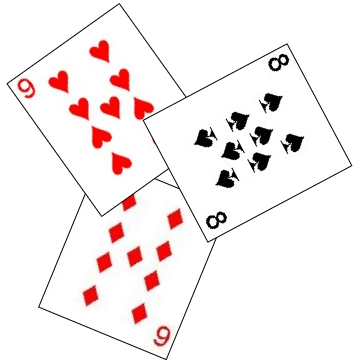
The dealer deals out nine cards to each player, in face-down packets of three. He begins the deal with the player to his immediate left and continues in a clockwise rotation around the table until the entire deck has been dealt.
The player to the immediate left of the dealer leads the first card to the first trick, and each other player then plays one card to that same trick in a clockwise rotation. There are no restrictions on what cards can be led or played to any trick, with players free to choose any card they have remaining in their hand.
After each player has played one card to the trick, it is reviewed to determine who has won the trick. The player of the highest card to the trick, based on the ranking above, is considered the winner of that trick. If two or more cards tie for the highest cards played to the trick, the first such card of that rank is considered the winning card. The cards from the played trick should be set aside, out of play. The winner of each trick leads the first card to the next trick.
While the goal of the game is to win as many tricks as possible in each hand, a larger goal is to manage to win 13 or more tricks over the course of any three games. A player who manages to do this is granted a special role and has special privileges during the game,
retaining these privileges as long as he continues to win at least 13
tricks over the course of three games. Once a player has been granted these privileges, on subsequent hands, he selects
either one of his opponents who must then give this player their highest card, and gives that player any other card from his hand
of choice, as a replacement. He can then require the other opponent to give him any seven, and he gives that player any card in exchange. If that player does not have any seven, no exchange occurs with that player. Once that player fails to win at least 13 tricks in any three consecutive games during play, he loses his special privileges and another player may obtain the privilege as able.
Copyright © 2015 CatsAtCards.com. All rights reserved.
 As mentioned previously, the remainder of the cards in the deck can be thought of as in several category of cards, which are:
As mentioned previously, the remainder of the cards in the deck can be thought of as in several category of cards, which are:
 After the Leader plays a Playable card to the table, each other player in turn then has the opportunity to play a card to this trick. He may only play a card to the trick if he has a higher ranked Playable card than the current highest card played to the trick. If the player has no higher ranked Playable card he can play to the trick he must simply pass,
not playing a card to this trick. After each other player has then had the opportunity to play to the trick, that trick is complete. The player of the highest ranked Playable card to the trick wins that trick, setting it aside, which is considered 1 "trick" for that player.
After the Leader plays a Playable card to the table, each other player in turn then has the opportunity to play a card to this trick. He may only play a card to the trick if he has a higher ranked Playable card than the current highest card played to the trick. If the player has no higher ranked Playable card he can play to the trick he must simply pass,
not playing a card to this trick. After each other player has then had the opportunity to play to the trick, that trick is complete. The player of the highest ranked Playable card to the trick wins that trick, setting it aside, which is considered 1 "trick" for that player.

 Once the cards have been dealt, the player to the dealer's immediate left then has the first turn. In leading to a trick, the leader may play any card of his choice from his hand, playing this card face-up near the center of the table to start the trick. If that player has multiple cards, all of the same
denomination (such as 3 nines), he may play all such cards as the lead
to that trick. Each other player in a clockwise direction then must play
the same number of cards, also face-up, to the trick as was first led to
it. There is no obligation to necessarily win the trick, although in
many cases players will attempt to thus win it for point scoring purposes. There is
one exception to this rule regarding attempting to beat a trick. If a
member of the opponent's team is currently winning the trick and the card
so winning the trick is the Jack of clubs, if the player has the King of
hearts in hand, he must play it as part of that trick in an attempt to
win the trick. In order for a player to attempt to actually win
the trick, he must beat each of the cards which are currently winning
that trick (play a higher ranked card). Although if leading to a
trick with multiple cards, all cards so led must be of the same rank,
there is no similar requirement on playing to (or winning) an existing
trick previously led by another player.
Once the cards have been dealt, the player to the dealer's immediate left then has the first turn. In leading to a trick, the leader may play any card of his choice from his hand, playing this card face-up near the center of the table to start the trick. If that player has multiple cards, all of the same
denomination (such as 3 nines), he may play all such cards as the lead
to that trick. Each other player in a clockwise direction then must play
the same number of cards, also face-up, to the trick as was first led to
it. There is no obligation to necessarily win the trick, although in
many cases players will attempt to thus win it for point scoring purposes. There is
one exception to this rule regarding attempting to beat a trick. If a
member of the opponent's team is currently winning the trick and the card
so winning the trick is the Jack of clubs, if the player has the King of
hearts in hand, he must play it as part of that trick in an attempt to
win the trick. In order for a player to attempt to actually win
the trick, he must beat each of the cards which are currently winning
that trick (play a higher ranked card). Although if leading to a
trick with multiple cards, all cards so led must be of the same rank,
there is no similar requirement on playing to (or winning) an existing
trick previously led by another player. Note that if one team manages to win all nine tricks during the hand, no scoring is earned by either team on that hand.
Note that if one team manages to win all nine tricks during the hand, no scoring is earned by either team on that hand.
 Alkort: Although Alkort is played similarly to Brus and some of the other games described on this page, it is much older than most of these, and is actually considered one of oldest games played in Iceland (mentioned in printed materials from the early 1700's). The basic game of Alkort is played by four players, playing in two partnerships of two players each. Each player should be seated directly across the table from his partner.
Alkort: Although Alkort is played similarly to Brus and some of the other games described on this page, it is much older than most of these, and is actually considered one of oldest games played in Iceland (mentioned in printed materials from the early 1700's). The basic game of Alkort is played by four players, playing in two partnerships of two players each. Each player should be seated directly across the table from his partner.
 Each of the players to the trick including the leader to a trick may play any card of choice, still remaining in his hand to the trick. The highest card played to the trick wins the trick. If two or more cards of the same rank (as per the ranking shown above) are tied for highest to be played to that trick, the first of these cards played to that trick is considered the highest. The winner of each trick leads the first card to the trick.
Each of the players to the trick including the leader to a trick may play any card of choice, still remaining in his hand to the trick. The highest card played to the trick wins the trick. If two or more cards of the same rank (as per the ranking shown above) are tied for highest to be played to that trick, the first of these cards played to that trick is considered the highest. The winner of each trick leads the first card to the trick.
 The dealer deals out nine cards to each player, in face-down packets of three. He begins the deal with the player to his immediate left and continues in a clockwise rotation around the table until the entire deck has been dealt.
The dealer deals out nine cards to each player, in face-down packets of three. He begins the deal with the player to his immediate left and continues in a clockwise rotation around the table until the entire deck has been dealt.